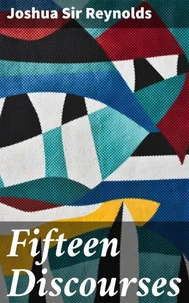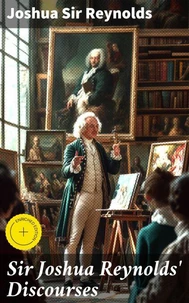Sir Joshua Reynolds' Discourses. Edited, with an Introduction, by Helen Zimmern
Par : ,Formats :
Disponible dans votre compte client Decitre ou Furet du Nord dès validation de votre commande. Le format ePub est :
- Compatible avec une lecture sur My Vivlio (smartphone, tablette, ordinateur)
- Compatible avec une lecture sur liseuses Vivlio
- Pour les liseuses autres que Vivlio, vous devez utiliser le logiciel Adobe Digital Edition. Non compatible avec la lecture sur les liseuses Kindle, Remarkable et Sony
 , qui est-ce ?
, qui est-ce ?Notre partenaire de plateforme de lecture numérique où vous retrouverez l'ensemble de vos ebooks gratuitement
Pour en savoir plus sur nos ebooks, consultez notre aide en ligne ici
- Nombre de pages239
- FormatePub
- ISBN859-65--4737612-5
- EAN8596547376125
- Date de parution16/09/2022
- Protection num.Digital Watermarking
- Taille578 Ko
- Infos supplémentairesepub
- ÉditeurDIGICAT
Résumé
In "Sir Joshua Reynolds' Discourses, " the renowned 18th-century painter provides a profound exploration of artistic principles, aesthetics, and the role of the artist in society. Written in a didactic and engaging style, these discourses reflect Reynolds' dedication to Enlightenment ideals, emphasizing the moral responsibility of the artist to convey beauty and virtue in their work. The text addresses various facets of painting, including composition, color theory, and the significance of classical references, serving as both a manifesto and a guide for aspiring artists.
Reynolds' insightful observations situate his work within the broader context of neoclassicism and its tension with evolving romantic ideals in art during his time. Joshua Sir Reynolds, a founding member of the Royal Academy, was instrumental in shaping 18th-century British art. His experiences as a portraitist for the aristocracy and involvement in the artistic community inform the depth and authority of his writings.
His commitment to educating future generations and his belief in art as a vehicle for moral and intellectual development are encapsulated in these discourses, which reflect his efforts to elevate the status of painting in a rapidly changing cultural landscape. "Sir Joshua Reynolds' Discourses" is an essential read for anyone interested in the philosophy of art, providing invaluable insights into the techniques and thought processes of one of Britain's most influential painters.
It is a timely reminder of the enduring power of artistic expression and the ever-relevant dialogue on the responsibilities of the artist.
Reynolds' insightful observations situate his work within the broader context of neoclassicism and its tension with evolving romantic ideals in art during his time. Joshua Sir Reynolds, a founding member of the Royal Academy, was instrumental in shaping 18th-century British art. His experiences as a portraitist for the aristocracy and involvement in the artistic community inform the depth and authority of his writings.
His commitment to educating future generations and his belief in art as a vehicle for moral and intellectual development are encapsulated in these discourses, which reflect his efforts to elevate the status of painting in a rapidly changing cultural landscape. "Sir Joshua Reynolds' Discourses" is an essential read for anyone interested in the philosophy of art, providing invaluable insights into the techniques and thought processes of one of Britain's most influential painters.
It is a timely reminder of the enduring power of artistic expression and the ever-relevant dialogue on the responsibilities of the artist.
In "Sir Joshua Reynolds' Discourses, " the renowned 18th-century painter provides a profound exploration of artistic principles, aesthetics, and the role of the artist in society. Written in a didactic and engaging style, these discourses reflect Reynolds' dedication to Enlightenment ideals, emphasizing the moral responsibility of the artist to convey beauty and virtue in their work. The text addresses various facets of painting, including composition, color theory, and the significance of classical references, serving as both a manifesto and a guide for aspiring artists.
Reynolds' insightful observations situate his work within the broader context of neoclassicism and its tension with evolving romantic ideals in art during his time. Joshua Sir Reynolds, a founding member of the Royal Academy, was instrumental in shaping 18th-century British art. His experiences as a portraitist for the aristocracy and involvement in the artistic community inform the depth and authority of his writings.
His commitment to educating future generations and his belief in art as a vehicle for moral and intellectual development are encapsulated in these discourses, which reflect his efforts to elevate the status of painting in a rapidly changing cultural landscape. "Sir Joshua Reynolds' Discourses" is an essential read for anyone interested in the philosophy of art, providing invaluable insights into the techniques and thought processes of one of Britain's most influential painters.
It is a timely reminder of the enduring power of artistic expression and the ever-relevant dialogue on the responsibilities of the artist.
Reynolds' insightful observations situate his work within the broader context of neoclassicism and its tension with evolving romantic ideals in art during his time. Joshua Sir Reynolds, a founding member of the Royal Academy, was instrumental in shaping 18th-century British art. His experiences as a portraitist for the aristocracy and involvement in the artistic community inform the depth and authority of his writings.
His commitment to educating future generations and his belief in art as a vehicle for moral and intellectual development are encapsulated in these discourses, which reflect his efforts to elevate the status of painting in a rapidly changing cultural landscape. "Sir Joshua Reynolds' Discourses" is an essential read for anyone interested in the philosophy of art, providing invaluable insights into the techniques and thought processes of one of Britain's most influential painters.
It is a timely reminder of the enduring power of artistic expression and the ever-relevant dialogue on the responsibilities of the artist.



